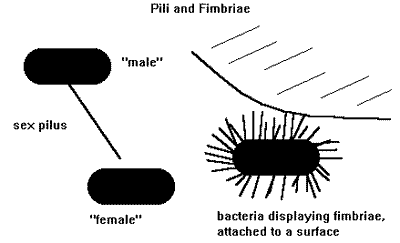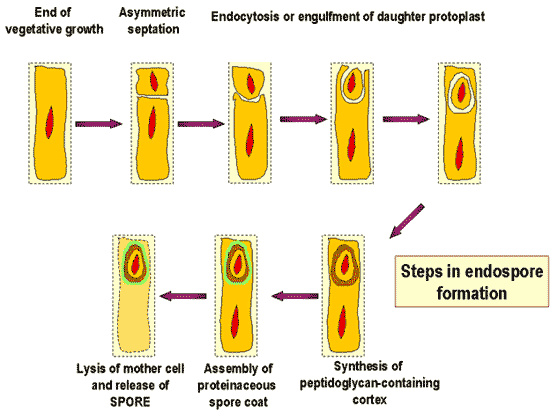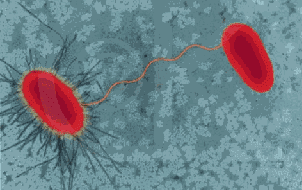| A | B |
|---|
| An organism that harnesses light energy to drive the synthesis of organic compounds from carbon dioxide is called a(n) _____. | photoautotroph |
| A short, hairlike prokaryotic appendage that functions in adherence to the substrate or to other cells is called _____. | fimbria (plural - fimbriae),  |
| An organism that needs only carbon dioxide as a carbon source but obtains energy by oxidizing inorganic substances is called a(n) _____. | chemoautotroph |
| An organism that must consume organic molecules for both energy and carbon is called a(n) _____. | chemoheterotroph |
| Organisms that must consume organic molecules for a source of carbon are called _____. | heterotrophs (The two types of heterotrophs are photoheterotrophs and chemoheterotrophs.) |
| Any organism that can use inorganic carbon dioxide as its carbon source is called a(n) _____. | autotroph (The two types of autotrophs are photoautotrophs and chemoautotrophs) |
| A microorganism that lives in an unusually saline ("salty") environment, such as the Great Salt Lake, or the Dead Sea, is called a(n) _____. | extreme halophile |
| Gram- _____ bacteria are often times more toxic than gram- ____ bacteria. | negative, positive,  |
| The assimilation of atmospheric nitrogen by certain prokaryotes into nitrogenous compounds that can be directly used by plants is called ____. | nitrogen fixation |
| The larger participant in a symbiotic relationship, serving as home and feeding ground to the symbiont is called the ____. | host |
| A microorganism that lives in an extreme environment is called a(n) ____. | extremeophile |
| What are three types of extremeophiles? | methanogens, extreme halophiles, and thermophiles |
| An organism that requires oxygen for cellular respiration and cannot live without it is called a(n) _____. | obligate aerobe |
| A component of the outer membrane of certain gram-negative bacteria responsible for generalized symptoms of fever and ache is called a(n) ____. | endotoxin |
| An organism that uses light to generate ATP but must obtain carbon in organic form is called a(n) _____. | photoheterotroph |
| A staining method that distinguishes between two different kinds of bacterial cell walls is called the ____. | gram stain,  |
| The sticky layer that surrounds the cell walls of some bacteria, protecting the cell surface and sometimes helping to glue the cell to surfaces is called the ____. | capsule,  |
| A thick-coated, resistant cell produced within a bacterial cell exposed to harsh conditions is called a(n) ____. | endospore,  |
| Movement toward or away from a stimulus is called _____. | taxis |
| A small ring of DNA that carries accessory genes separate from those of a bacterial chromosome is called a(n) ____. | plasmid (plasmids are also found in some eukaryotes, such as yeast),  |
| An ecological relationship between organisms of two different species that live together in direct contact is called _____. | symbiosis |
| An organism that absorbs nutrients from the body fluids of living hosts would be classified as a(n) ____. | parasite |
| The use of living organisms to detoxify and restore polluted and degraded ecosystems is called ____. | bioremediation |
| A toxic protein that is secreted by a bacterial cell and that produces specific symptoms even in the absence of the bacterium is called a(n) _____. | exotoxin |
| A long, hairlike prokaryotic appendage that functions in adherence or in the transfer of DNA during conjugation is called a(n) ____. | pilus (plural - pili),  |
| A bacterium that absorbs nutrients from nonliving organic materials such as corpses, fallen plant material, and the wastes of living organisms and converts them into inorganic forms would be classified as a(n) ____. | decomposer |
| A process that uses inorganic molecules other than oxygen to accept electrons at the downhill end of electron transport chains is called ____. | anaerobic respiration |
| A symbiotic relationship in which the symbiont benefits at the expense of the host is called ____. | parasitism |
| A symbiotic relationship in which both participants benefit is called ____. | mutualism |
| The smaller participant in a symbiotic relationship, living in or on the host is called the ____. | symbiont |
| A type of polymer in bacterial cell walls consisting of modified sugars cross-linked by short polypeptides is called a(n) ____. | peptidoglycan |
| A microorganism that obtains energy by using carbon dioxide to oxidize hydrogen, producing methane as a waste product is called a(n) ____. | methanogen |
| An organism that makes ATP by aerobic respiration if oxygen is present, but that switches to fermentation under anaerobic conditions, is called a(n) ____. | facultative anaerobe |
| The region in a prokaryotic cell consisting of a concentrated mass of DNA is called the _______. | nucleoid region,  |
| An organism that cannot use oxygen and is in fact poisoned by it is called a(n) _____. | obligate anaerobe |
| A surface-coating colony of prokaryotes that engage in metabolic cooperation is called a(n) ____. | biofilm |
| A symbiotic relationship in which the symbiont benefits but the host is neither helped nor harmed is called _____. | commensalism |
Prokaryotic cells lack _______, 
| a nucleus and other membrane-bound organelles |
| Cells that have a nucleus and organelles are called ____ cells. | eukaryotic, 
|
| What are three different shapes that bacteria can be? | spheres (cocci), rod-shaped (bacilli), spiral |
| Bacteria that stain purple are known as _______ . | gram-positive bacteria,  |
| Bacteria that don't stain purple are known as ______. | gram-negative bacteria,  |
| Mutualism, parasitism and commensalism are all types of ____. | symbiosis, 
|
| Some bacteria have a whip-like tail called a ____. | flagellum, 
|
| The structure just outside the cell membrane of a bacterium is called the ___. | cell wall,  |
| Which gas in the atmosphere do some bacteria capture and turn into fertilizer that plants can use? | nitrogen |
| Medicines that kill bacteria as well as other living microorganisms are known as ____. | antibiotics, 
|
| What's a major difference between the cell walls of the bacteria in domain Archaea and those in the domain Bacteria? | Archaean cell walls lack peptidoglycan. |
| Compare gram-positive and gram negative bacteria for the amount of peptidoglycan in their cell walls and their structural complexity. | Gram-positive bacteria have more peptidoglycan in their cell walls and their cell walls are structurally simpler compared to gram-negative bacteria.,  |
| Fimbriae and pili are both hairlike structures that help some bacteria adhere to surfaces. Fimbriae are usually ____ numerous and ____ than pili. | more, shorter,  |
| Specialized pili, called sex pili, link prokaryotes during ______, a process in which one cell transfers DNA to another cell. | conjugation,  |
| What are two major differences between the flagella of prokaryotes and the flagella of eukaryotes? | Eukaryotic flagella are about 10 times thicker and are covered by an extension of the cell membrane.,  |
| A single cell cannot carry out ______ and photosynthesis at the same time. | nitrogen fixation |
| A single cell cannot carry out ______ and nitrogen fixation at the same time. | photosynthesis |
| What is the name of the bacteria that live within the root nodules of legumes (plants of the pea/bean family) and fix nitrogen? | Rhizobium |
| What is the scientific name of the bacteria that reside in the intestines of mammals, including humans? | Escherichia coli (E. coli) |
| What do you call the photosynthetic oxygen producing bacteria? | Cyanobacteria (A.k.a. - Blue-green bacteria) |